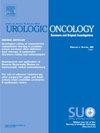UTILITY OF TUMOR-INFORMED CIRCULATING TUMOR DNA (CTDNA) IN PATIENTS UNDERGOING RETROPERITONEAL LYMPH NODE DISSECTION FOR TESTICULAR CANCER
IF 2.4
3区 医学
Q3 ONCOLOGY
Urologic Oncology-seminars and Original Investigations
Pub Date : 2025-03-01
DOI:10.1016/j.urolonc.2024.12.084
引用次数: 0
Abstract
Introduction
Circulating tumor DNA (ctDNA) has been gaining popularity in directing and tailoring treatment modalities in solid cancers. ctDNA utility before and after diagnosis of testicular cancer has not yet been well-characterized. We seek to characterize the utility of ctDNA in correlation with pathologic and clinical features in patients with testicular cancer who underwent retroperitoneal lymph node dissection (RPLND).
Methods
Our single institution prospectively maintained database identified consecutive patients who underwent radical orchiectomy for germ cell tumor (GCT) between 2021 - 2023, included were patients who had prospectively collected ctDNA (SignateraTM) analyses performed before and after RPLND. ctDNA signature was informed from the radical orchiectomy specimen in 9 patients and from the RPLND specimen in 8 patients (Figure 1). The informed signature was used throughout the patient's surveillance. Pre-RPLND ctDNA status was determined from blood drawn prior to surgery, and the post-RPLND minimal residual disease (MRD) window ctDNA status was determined from blood drawn after and within 90 days from RPLND. Study findings were reported using descriptive statistics. R programming language version 4.3.1 was used for all statistical analyses.
Results
Seventeen patients had 89 ctDNA analyses performed before and after RPLND. The median age was 31 (IQR 25-33). The median follow-up time was 11 months (IQR 7-13). The primary testicular pathology prior to RPLND was non-seminoma for 14 patients (82.3%), seminoma for 2 patients (11.7%), and one patient had primary retroperitoneal seminoma (5.8%). Nine patients underwent primary RPLND (53%), 6 underwent post-chemotherapy RPLND (PS-RPLND, 35%) and 2 patients had RPLND performed due to recurrence while on surveillance for clinical stage I (11.7%). Serum tumor markers (STM) were normal for all the patients prior to RPLND. Pre-RPLND ctDNA status was available for 13 patients, ctDNA was undetectable in 8 patients (5 had benign pathology and 3 had teratoma), and detectable in 5 patients (38%); among them, 4 had viable GCT and one had teratoma. Fourteen patients had ctDNA MRD window status available. Four had detectable ctDNA status (28.5), all of them had disease progression (100%) and received further chemotherapy after RPLND. Only 1 of the 4 patients had elevated STM after RPLND (25%). Ten patients (71.4%) had undetectable MRD ctDNA status, 9 patients (90%) are currently under surveillance without evidence of disease recurrence, and one patient received adjuvant chemotherapy after RPLND without evidence of disease recurrence, all had post-RPLND normal STM. Detectable pre-RPLND ctDNA signature was found only in 1 of 4 patients with teratoma on RPLND histology (25%).
Conclusions
Detectable ctDNA status in the pre-RPLND status was associated with viable GCT on histology while having normal STM. Undetectable pre-RPLND ctDNA was associated with either no tumor or teratoma on histology. Detectable ctDNA status at the MRD window was associated with disease progression in all patients while only 25% had elevated STM. While preliminary, ctDNA status may be used in the future to inform both urologists and oncologists when tailoring treatment protocols to patients with negative/mildly elevated serum tumor markers and for treatment escalation/de-escalation. Prospective studies with larger cohorts are necessary to validate these initial results.
肿瘤信息循环肿瘤DNA (ctdna)在睾丸癌腹膜后淋巴结清扫患者中的应用
循环肿瘤DNA (ctDNA)在指导和定制实体癌治疗方式方面越来越受欢迎。睾丸癌诊断前后的ctDNA效用尚未得到很好的表征。我们试图描述ctDNA与接受腹膜后淋巴结清扫(RPLND)的睾丸癌患者的病理和临床特征的相关性。方法单一机构前瞻性维护的数据库确定了2021 - 2023年间接受根治性睾丸切除术治疗生殖细胞肿瘤(GCT)的连续患者,包括在RPLND前后前瞻性收集ctDNA (SignateraTM)分析的患者。从9例患者的根治性睾丸切除术标本和8例患者的RPLND标本中获得了ctDNA签名(图1)。在整个患者监测过程中都使用了知情签名。RPLND前的ctDNA状态通过术前采血确定,RPLND后最小残留病(MRD)窗口ctDNA状态通过RPLND后和术后90天内采血确定。研究结果采用描述性统计报告。所有统计分析均采用R程序设计语言4.3.1版本。结果17例患者在RPLND前后进行了89次ctDNA分析。中位年龄31岁(IQR 25-33岁)。中位随访时间为11个月(IQR 7-13)。RPLND前的原发睾丸病理为非精原细胞瘤14例(82.3%),精原细胞瘤2例(11.7%),原发性腹膜后精原细胞瘤1例(5.8%)。9例患者发生原发性RPLND(53%), 6例患者发生化疗后RPLND (PS-RPLND, 35%), 2例患者在临床I期监测期间因复发而行RPLND(11.7%)。在RPLND之前,所有患者的血清肿瘤标志物(STM)均正常。13例患者可获得rplnd前ctDNA状态,8例患者未检测到ctDNA(5例为良性病理,3例为畸胎瘤),5例患者(38%)可检测到ctDNA;其中GCT存活4例,畸胎瘤1例。14例患者ctDNA MRD窗口状态可用。4例检测到ctDNA(28.5),所有患者均有疾病进展(100%),RPLND后接受了进一步化疗。4例患者中只有1例RPLND后STM升高(25%)。10例患者(71.4%)MRD ctDNA未检测到,9例患者(90%)目前正在接受监测,无疾病复发证据,1例患者在RPLND后接受辅助化疗,无疾病复发证据,RPLND后STM均正常。4例畸胎瘤患者中只有1例(25%)在RPLND组织学上发现可检测到的RPLND前ctDNA特征。结论在STM正常的情况下,rplnd前的ctDNA检测水平与组织学上存活的GCT相关。未检测到的rplnd前ctDNA与组织学上无肿瘤或畸胎瘤相关。MRD窗口可检测的ctDNA状态与所有患者的疾病进展相关,而只有25%的患者STM升高。虽然是初步的,但ctDNA状态可能在未来用于告知泌尿科医生和肿瘤科医生为血清肿瘤标志物阴性/轻度升高的患者量身定制治疗方案以及治疗升级/降级。需要更大规模的前瞻性研究来验证这些初步结果。
本文章由计算机程序翻译,如有差异,请以英文原文为准。
求助全文
约1分钟内获得全文
求助全文
来源期刊
CiteScore
4.80
自引率
3.70%
发文量
297
审稿时长
7.6 weeks
期刊介绍:
Urologic Oncology: Seminars and Original Investigations is the official journal of the Society of Urologic Oncology. The journal publishes practical, timely, and relevant clinical and basic science research articles which address any aspect of urologic oncology. Each issue comprises original research, news and topics, survey articles providing short commentaries on other important articles in the urologic oncology literature, and reviews including an in-depth Seminar examining a specific clinical dilemma. The journal periodically publishes supplement issues devoted to areas of current interest to the urologic oncology community. Articles published are of interest to researchers and the clinicians involved in the practice of urologic oncology including urologists, oncologists, and radiologists.

 求助内容:
求助内容: 应助结果提醒方式:
应助结果提醒方式:


